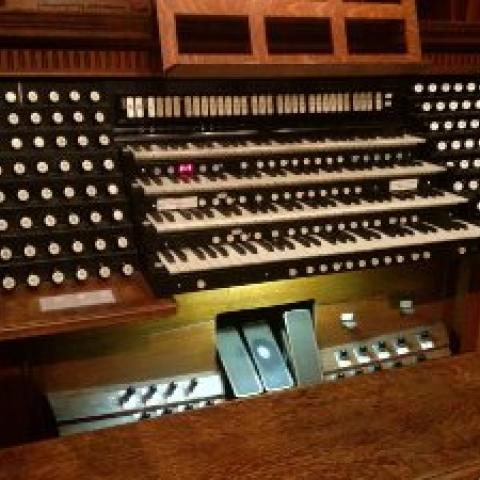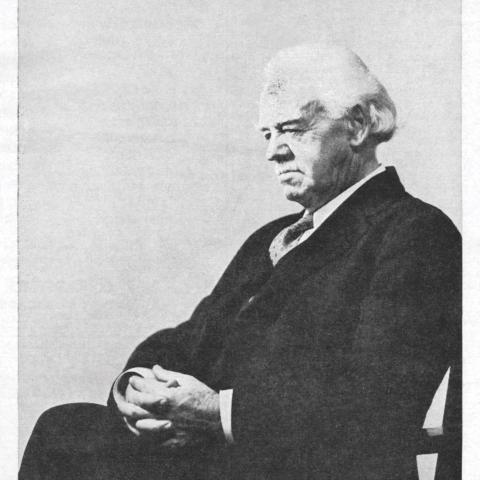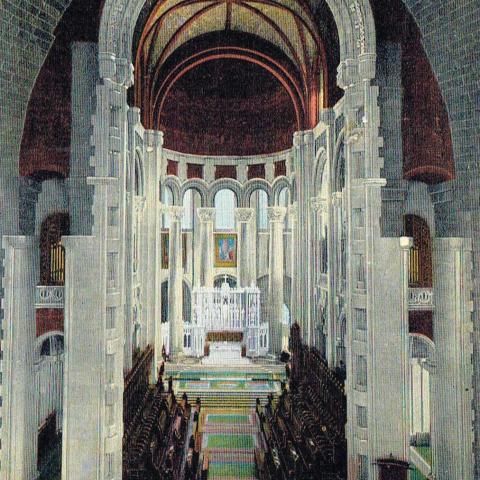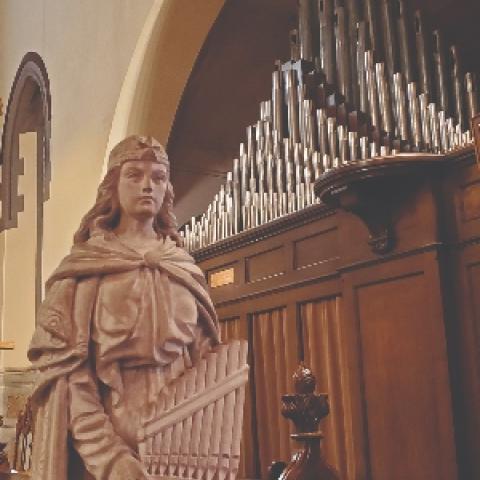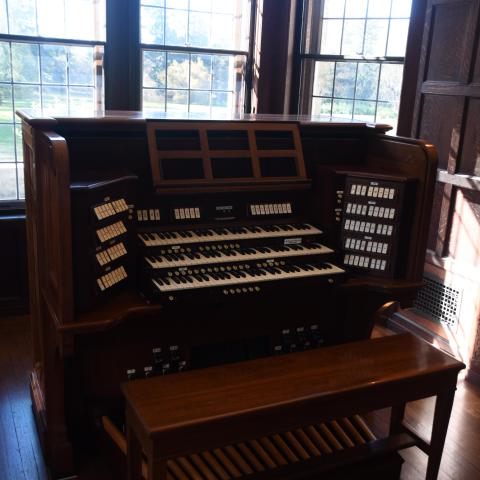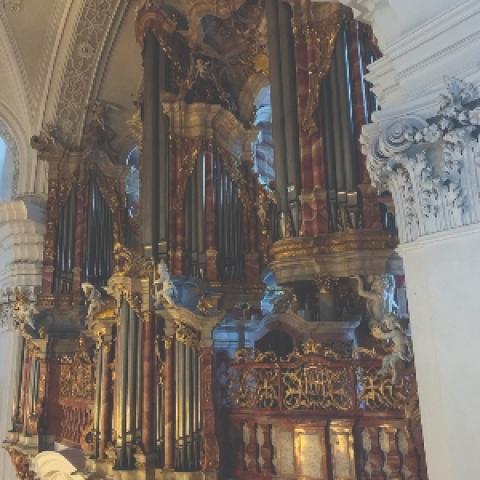Neal Campbell is the organist of Trinity Episcopal Church in Vero Beach, Florida. He previously held full-time positions in Connecticut, Virginia (including ten years on the adjunct faculty of the University of Richmond), and New Jersey. He holds graduate and undergraduate degrees from the Manhattan School of Music, including the Doctor of Musical Arts degree, for which he wrote his dissertation on the life and work of New York organist-composer Harold Friedell. He has studied, played, and recorded on many of the organs discussed in this article.
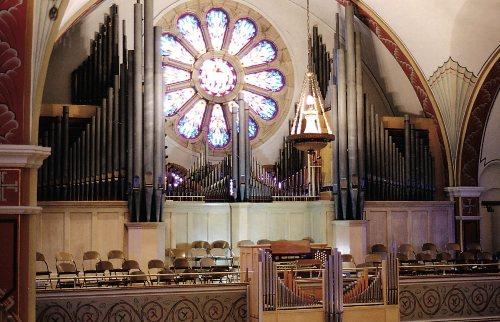
Editor’s note: the first part of this series appeared in the February 2022 issue of The Diapason, pages 12–17.
Introduction
Based on correspondence in Barbara Owen’s and Charles Callahan’s books, we learned in the previous issue that it was Alexander Schreiner who, as the Tabernacle organ was nearing completion, asked G. Donald Harrison to have his name appear on the console in addition to the standard company nameplate. Harrison obliged by providing an ivory plate with a facsimile of his signature along with the opus number and date. In the ensuing years until his death in 1956 Harrison continued the practice of signing some organs built by Aeolian-Skinner with which he was personally involved.
Before identifying and commenting on those signature organs, a list which continues this month, I showed the progression of Harrison’s tonal ideas in the years leading up to the Tabernacle organ, based on his own words in letters to various of his associates and friends contained in Callahan’s books. In particular, GDH related that the organ for the Groton School was a turning point in the development of his tonal theories, and he considered it the smaller companion to the Tabernacle design. Also cited are several examples of both Harrison’s and Schreiner’s assessments of the Tabernacle organ in the years immediately following its completion.
Following the list of signature organs in this issue, I also comment on some organs built prior to the Tabernacle organ containing GDH’s signature plate and, assuming the Tabernacle organ to be the first organ GDH signed, I offer details as to their relative importance in the company trajectory. There follows commentary about significant Aeolian-Skinner organs of the era that do not contain Harrison’s signature, and then some brief commentary on the organs built in the era of Joseph S. Whiteford and the company’s final years.
In enumerating and commenting on the signature organs, the list and details are complete and accurate so far as I know. I have played many of the organs, but not all. I imagine there are signature organs of which I am unaware. For example, since beginning work on this article I learned via a Facebook page devoted to G. Donald Harrison and the American Classic Organ that the organ in the Worcester Art Museum bears a GDH signature plate. There likely are others, and I would be glad to hear from those with knowledge of them, preferably with documentation, and from those with additional commentary to what I provide here. Communications may be sent through the editor. Who knows, there may be an addenda or part 3 in the future!
Opus 1149: New York Avenue Presbyterian Church, Washington, D.C., 1948.
The first organ for this congregation was built by Hutchings, Plaisted, & Co. in 1873 for the original church. This was later rebuilt by John Brown and later still by Ernest M. Skinner & Son of Methuen. In 1948, the church signed a contract with Aeolian-Skinner for additions to the existing instrument, and in 1951 another contract was signed as Opus 1149-A for a rebuilding and re-installation in the present church.29
This organ, now gone, was a very beautiful example of Aeolian-Skinner’s sound, even though it was of modest content and pedigree. My teacher, William Watkins, was the organist of the church at the time each contract was completed, and he and Joseph S. Whiteford did the work together on a very modest budget. Whiteford was a native Washingtonian, and he and Watkins were good friends; this was at about the time Whiteford became Harrison’s assistant at Aeolian-Skinner.
At the time, the church was famous for the preaching ministry of the Reverend Dr. Peter Marshall, who was also the chaplain of the United States Senate. Watkins at that time was a prominent concert organist, and he provided a serious program of organ music at services. The church maintained a choir of 100 singers directed by Charles Dana Beaschler. Watkins told me that he simply asked Harrison to sign the organ when they moved into the new church. At the time Watkins was probably the best-known organist in the country aside from Virgil Fox, his teacher. The organ as it turned out was entirely worthy of the Aeolian-Skinner legacy, but GDH had nothing to do with it personally. He complied with the request solely on the strength of his associations with Whiteford and Watkins. So, if it happened here, it likely happened in other places—an important clue when considering criteria that may have influenced Harrison’s decision to sign an organ.
By the time I knew the organ as a substitute in the early 1970s the signature plate had disappeared, though the screw holes where it had been were clearly visible. When the church eventually obtained a new console and made some additions during the tenure of Wesley Parrott, a replacement signature plate was made and affixed to the new console.
Opus 1150: Annie Merner Chapel of MacMurray College, Jacksonville, Illinois, 1952.
Robert Glasgow taught here before he went to the University of Michigan, and the organ was installed early in his tenure. He praised the organ in his address to the American Classic Organ Symposium in 1988. The college closed in May 2020, and the fate of the organ is still being determined.
Opus 1173: First Presbyterian Church, Kilgore, Texas, 1949.
This organ was a rebuild of a 1935 M. P. Möller, and it retained much of the pipework and structure, as well as three complete stops from the previous Henry Pilcher’s Sons organ. Nevertheless, it became one of the company’s most successful and best-known organs.
It was used for examples supporting GDH’s narration in Volume I of King of Instruments, and in Volume II played by Roy Perry, the organist of the church for forty years and one of Aeolian-Skinner’s most successful representatives and finishers. Two tracks were also played by William Watkins on Volume II, although he was identified ignominiously as the “staff organist,” owing to union regulations at the time. Volume X featured Opus 1173 in a complete issue entitled “Music for the Church,” featuring works for choir and organ. The only organ piece on the album was Bruce Simonds’s Prelude on Iam sol recedit igneus played by Roy Perry, who also played all of the choral accompaniments.
The cover photo of the new Trompette-en-Chamade for Opus 1173 was used for the first time on Volume X and continued to be featured in company brochures and other volumes of the King of Instruments series, becoming something of an Aeolian-Skinner icon. The company claimed that the stop was the first such built in America.
Opus 1174: First Baptist Church, Longview, Texas, 1951.
This organ provides an interesting contrast to its slightly older sister organ in Kilgore in that it was a completely new organ designed by Harrison for the new church, has not been altered or added to, and was placed in a strikingly modern, large edifice designed with the organ’s success in mind at the outset. The nave of the church is 92 feet high at the peak of the ceiling, and it seats 1,700 persons. The church’s pastor, the Reverend Dr. W. Morris Ford, was the driving force in both the building of the new church and the organ, and for many years thereafter musical events of significant proportions were included in the church’s program. The leading organists of the day, including Virgil Fox and Catharine Crozier, played there. An article about this organ appeared in the June 1954 issue of The American Organist stating:
Catharine Crozier made tape-recordings during the 1952 Christmas holidays for two L.P. discs [on the Kendall label]; Harold Gleason says Longview beats anything he has heard in Europe.
Opus 150-A: Cathedral Church of St. John the Divine, New York City, 1953.
This organ is justly famous and needs little introduction, except to note that it used significant portions of the original instrument, one of Ernest Skinner’s early successes, especially structural components and orchestral stops. The organ has many unique attributes, and its success draws in large part from Harrison’s experience prior to his coming to the United States, when he worked closely with Willis on the organ in Liverpool Cathedral, a building approaching the size of St. John the Divine. For example, letters by GDH tell that in some stops the pipes for the individual notes are doubled, even tripled in the treble ranks, and that for the first time in many years Aeolian-Skinner built and voiced completely new Tuba stops for the organ.
An amusing story from the canon of oral tradition tells of Norman Coke-Jephcott, organist of the cathedral during the planning stages, and GDH visiting after dinner at Coke-Jephcott’s club in the presence of others, when Harrison asked “Cokie” if he had given any thought to what they might name the newly designed special trumpet stop at the west end of the cathedral. Cokie said that he really had not, so Harrison asked him how he planned to use it. Cokie said, “Well . . ., I suppose for state occasions.”
That is how this famous stop, voiced by Oscar Pearson on fifty inches of wind pressure, came to be called the State Trumpet. It was a major departure from the two previous horizontal reeds Aeolian-Skinner built for Opus 1173 and Opus 1208, which were essentially standard Trompette Harmonique designs voiced on moderate pressure, but mounted horizontally.
The cathedral organ is featured on Volume I of the King of Instruments in examples played by Joseph Whiteford to accompany Harrison’s narration. The instrument is again featured on Volume VI in a program played by Alec Wyton, who had recently been appointed organist of the cathedral, and on Volume VIII, played by his predecessor, Norman Coke-Jephcott.
Opus 825-A: St. Paul’s School, Concord, New Hampshire, 1953.
Opus 1196: Covenant Presbyterian Church, Charlotte, North Carolina, 1949.
This was a completely new four-manual organ for the new church building of this flagship congregation of the denomination. Richard Peek was the organist at the time, and he and his wife, Betty, directed the music here for over forty years.
Opus 1200: New England Conservatory, Boston, Massachusetts, 1949.
Originally displayed at the 1950 American Guild of Organists convention in Boston, this experimental organ saw many years of use in a studio at the conservatory. The console has three plates on it, and students recall that in addition to the company nameplate and the GDH signature plate, there was a plate identifying its use at the convention. The organ is now owned privately.
Opus 1201: St. Mark’s Episcopal Church, Mount Kisco, New York, 1952.
A new three-manual organ of classic design was installed in casework designed by Bertram Grosvenor Goodhue, architect of the church, which contained the former instrument. The organ featured a divided Swell division, such as was first used in one of Ernest White’s studio organs at St. Mary the Virgin in New York City, and later at Christ Church, Bronxville, New York, Opus 1082. The Positiv division is suspended from the ceiling at the entrance to the side chapel, across the chancel from the main organ. Edgar Hilliar, organist of the church from 1948 until 1984, directed much of the design, and he recorded a complete program for Volume IV of the King of Instruments series.
Opus 1208: St. Philip’s Episcopal Church, New York City, 1951.
At the time the organ was installed, St. Philip’s was one of the largest Episcopal churches in the country and was a significant religious and political presence among the many churches in Harlem. The organ was a rebuild of the former 1943 Hillgreen-Lane organ of three manuals, reusing the console. It featured the company’s second Trompette-en-Chamade, which is similar in appearance to the one for Opus 1173 in Kilgore, Texas, except St. Philip’s is at the west end of the church.
Opus 1216: First Methodist Church, Tacoma, Washington, 1953.
Since relocated to First Baptist Church, Seattle, Washington.
Opus 1235: St. John Lutheran Church, Forest Park, Illinois, 1954.
Photographs of the stopjambs of this organ were used as the cover of company brochures in the 1960s. The Positiv was prepared for at the time and later added by Berghaus Organ Company to a design somewhat different than the original.
Opus 968-B: Bruton Parish Church, Williamsburg, Virginia, 1955.
This was a large, four-manual organ of over 100 ranks with obvious Harrison attributes. The instrument also included an English organ from 1785 built by Samuel Green that had been donated to the church, made playable as a division of the organ. The unenclosed divisions were placed in a shallow gallery surrounding the Green organ over the altar, while the enclosed divisions were in attic chambers, including an Antiphonal division in the tower. The organ was an anachronism in the Colonial-era church, but it was very effective and saw much varied use in recitals several times a week for the many tourists who flocked to Williamsburg. The organ was replaced in 2019 by Dobson Pipe Organ Builders Opus 96.
Opus 1257: Winthrop College, Rock Hill, South Carolina, 1955.
Opus 1265: The Temple, Atlanta, Georgia, 1954.
Emilie Spivey, the organist of The Temple, commissioned Harrison to rebuild the 1931 Henry Pilcher’s Sons organ that had been installed in the new edifice. The new organ retained twenty-two ranks from the Pilcher. Virgil Fox was the consultant.
Opus 1275: Cathedral Church of All Saints, Albany, New York, 1953.
This is a rebuild of a 1904 Austin Organ Company instrument, retaining the console and some of the chests and pipework. There is a signature plate indicating that Harrison was responsible for the Great and Positiv divisions, and another indicating that Whiteford finished the Swell and Choir.
Opus 724-A: St. Paul’s Episcopal Church, Chestnut Hill, Philadelphia, Pennsylvania, 1956.
Significant structural portions and the three-manual console were retained from the previous organ, but little of the previous pipework was used in this rebuild, which was in the factory simultaneous with Opus 205-A for St. Thomas Church in New York City. Inasmuch as Harrison died while finishing the organ in St. Thomas, this organ may justly be identified as the last organ personally finished by G. Donald Harrison. Designed and installed during the tenure of Thomas Dunn, certain aspects of the unusual design and stop nomenclature have been attributed to him. The original Aeolian-Skinner nameplate and GDH signature plate were stolen, and the present console contains replacements.
Over the years, during the long tenure of Richard Alexander, additions to the organ included a new four-manual console built by Austin and several vintage Skinner stops, which were placed in the large ceiling chamber toward the front of the nave where most of the original Skinner organ had been located. A new Grand Choeur division built by Schoenstein was also added.
Opus 205-A: St. Thomas Church, New York, New York, 1956.
Much has been written about this famous organ, and it has become the fodder of legend, beginning with the fact that G. Donald Harrison died on the evening of June 14, 1956, after spending a day of tonal finishing on the organ as it neared completion, working against the clock to have it ready for the American Guild of Organists national convention a few weeks later. There was a subway strike in New York at the time, and GDH could not get a taxi, so he walked several blocks in extreme heat to the apartment he and his wife maintained on Third Avenue. Upon arriving home he felt poorly, but after dinner he relaxed and felt better. As he was watching Victor Borge on the television, he threw his head back roaring in laughter—and died of a sudden heart attack.
Many alterations were made to the organ over the years beginning in the late 1960s when the organ was barely a decade old. Toward the end of Gerre Hancock’s tenure he retrofitted nameplates on the right stop jamb documenting the provenance of the organ: The Ernest M. Skinner Co., Boston; Aeolian-Skinner; and Gilbert Adams. He also placed a GDH signature plate under the bottom manual near the General Cancel button.
Marcel Dupré made two stereo recordings for the Mercury Living Presence series of LPs in 1958, which assured the organ of a place in the annals of Aeolian-Skinner history. Private recordings of rehearsals and concerts by Marie-Madeleine Duruflé, Alexander Boggs Ryan, and Garnell Copeland made on the organ before the long series of alterations have recently been remastered and made available as CDs, the latter two of which are found on the Aeolian-Skinner Legacy series of recordings obtainable through the East Texas Pipe Organ Festival.
Signature organs prior to Opus 1075
Several organs built prior to the Salt Lake Tabernacle Opus 1075 also have a Harrison signature plate affixed to the console. Assuming that the Tabernacle organ was the first that Harrison signed as Barbara Owen states (see endnote #1), the exact circumstances of the placements of signatures on these pre-existing organs are subjects of further conjecture and add another layer of mystique to a subject that is inherently somewhat esoteric and imprecise.
The trajectory of Harrison’s organs culminating in the Tabernacle organ design has already been traced. That some of these organs were later given Harrison’s signature is entirely logical, as they contain many design precedents found in the Tabernacle organ that led Alexander Schreiner to ask Harrison to sign it in the first place. In that Harrison and Aeolian-Skinner later made alterations to some of these organs, it is likely that GDH himself directed his signature plate to be affixed at that time. In others the provenance is less obvious, and the exact logistics regarding their placement may be details consigned to the ages. I have attempted only to document what I know to have been in place at the time of this writing or at some point in the past. It is not difficult to fabricate these signature plates, and in several instances where the original nameplates have been stolen or broken, replacement replicas have been made available with relative ease.
Nora Williams told the story of someone in the console engraving department who would routinely make keychain fobs out of Harrison signature plates to hand out to workers and friends! So, the mystique continues.
Opus 909-A: All Saints Episcopal Church, Worcester, Massachusetts, 1933, 1940–1949.
The organ was recorded for Volume XI of the King of Instruments series played by Henry Hokans, the organist of the church at the time.
Opus 910-A: Grace Episcopal Cathedral, San Francisco, California, 1933, 1952.
Richard Purvis played a program of his compositions for Volume V of King of Instruments, although he was identified simply as “staff organist.”
Opus 927: Trinity Church on the Green, New Haven, Connecticut, 1935, 1949.
Opus 932-A: Calvary Episcopal Church, Memphis, Tennessee, 1935, 1952.
Harrison’s professional correspondence mentions his traveling to Memphis to work on the organ. Adolf Steuterman was the long-time organist of Calvary Church, a respected musician in that city, and was friendly with GDH.
Opus 936: St. John’s Chapel, Groton School, Groton, Massachusetts, 1935, 1945–1962.
The organ was featured for Volume VII of King of Instruments, played by Marilyn Mason.
Opus 940: Episcopal Church of the Advent, Boston, Massachusetts, 1935, 1964.
Opus 1024: University of Texas at Austin, Recital Hall, Austin, Texas, 1941.
This was a large, four-manual organ for the recital hall in the new music building, containing the usual four manual divisions, plus a Positiv, Bombarde, and floating String organ. A new console was provided in 1965 as Opus 1024-A, which does not contain a Harrison signature plate. The organ has since been installed in a new church building for St. Andrew’s Episcopal Church in Amarillo, Texas, which has been widely documented on video, and a signature plate is not on it.
However, in a letter to Brock Downward for his dissertation about Harrison, E. William Doty, professor emeritus and long-time organ teacher at the university, wrote that:
After the College of Fine Arts had been in existence for two years, the Board of Regents authorized the construction of a music building plus an organ to go in the recital hall . . . . Its acoustics were designed by C. C. Potwin of Electrical Research Corporation. He was recommended by Paul Boner, UT Professor of Physics, who was one of several consultants on the building and the organ. Ned Gammons of Christ Church, Houston, now at Groton School was another consultant whose ideas on design were incorporated . . . . In my judgement [sic] G. Donald Harrison was the greatest artist tonal designer of the first half of this century and we are very proud that he signed the University of Texas organ because in his judgement it was one of his best.30
So, the mystique continues, but there is no doubt that this organ in its new home is a success and probably far exceeds its effectiveness in its original location according to those who knew it then, including Gerre Hancock who studied on it with Doty when he was a student at the university.
Opus 1036: Worcester Art Museum, Worcester, Massachusetts, 1942.
Conclusions
Beginning with the Groton organ in 1935, which Harrison himself identified as a turning point in his design of the Classic organ, it is a fairly straightforward task to identify further similar designs throughout the 1930s and 1940s leading up to the Tabernacle organ in 1945—and from thence to others in a similar trajectory, which GDH himself then signed, up until his death in 1956. Even so, if one were listening to a variety of the company’s instruments during this period, whether signed or not, there is no foolproof, obvious, definite distinction. Similarly, from a technical standpoint there are no absolute defining attributes or “smoking gun” signals that separate an organ that GDH signed from one he did not. They each bear a family resemblance in sight and sound, and some may be said to be more effective than others for any number of tangible and intangible reasons. It is, however, a given assumption that these signature organs are considered to be the best of the best that the company built.
In addition to tonal and technical attributes, however, there is another intangible aspect to the signature question that, from a purely scientific standpoint, is difficult to precisely define. Given the uniform tonal success of each of the signature organs along GDH’s developing Classic designs, I feel certain that, when all is said and done, Harrison’s reason for signing an organ also represented some very personal, quiet tribute of his own bestowing—some personal affinity GDH had for the way a particular job turned out, occasioned by its design and outcome together with perhaps some pleasant personal association with the incumbent, such as clearly was the case with Opus 1149 in Washington. Or perhaps there was the sense of a successful achievement that involved working with a collaborator on the job that reminded Harrison of his association with Schreiner and the outcome of the Tabernacle organ. There may have been some personal affinity that prompted Harrison to pronounce his own benediction on the job. And Philip Steinhaus’s letter to William Self at the outset of part 1 of this article confirms that the signature organs represent jobs with which Harrison was “deeply and personally involved.”
There certainly are wide varieties of styles to the signature organs, located in places humble and impressive, sizes small and large. Most of them are complete organs of GDH’s sole design that echo his aspirations for the Tabernacle organ, although there are obvious exceptions that contain significant portions of other builders’ work. Some signature organs are rather straightforward manifestations placed in ideal locations, and some are very unusual schemes or are the result of challenging layouts and unusual engineering solutions, such as Opus 1201 in Mount Kisco.
Some scholars and historians have posited that signature organs contain only pipework designed and finished by G. Donald Harrison. However, there are several examples that clearly suggest otherwise, such as the Washington and Kilgore organs cited previously, but also Opus 1265 at the Temple in Atlanta, Opus 1275 for the Cathedral in Albany, Opus 1208 in Harlem, Opus 1134 for Symphony Hall in Boston, and the various rebuilds of original Skinner organs that are indicated by the suffix letter “A” following the original opus number.
It is also very interesting to consider some important Aeolian-Skinner organs that were not signed by Harrison, including two of the company’s most famous: The Mother Church in Boston (Opus 1203 in 1949, the largest single organ produced by the company) and The Riverside Church in New York (Opus 1118, 1947–1955). Each is a very large, beautiful organ, in a prominent church in a major city, containing many singular attributes associated with Harrison and the American Classic Organ movement. Each possesses a sound that is unmistakable as being from Aeolian-Skinner of the era. However, each of these landmark organs was designed under the significant influence of others—in this case Lawrence Phelps and Virgil Fox, respectively. That is, their design inception was just the opposite of Opus 1075 for the Salt Lake Tabernacle where GDH was given a free hand and charged at the outset to build the organ as he saw fit. So it seems likely that GDH may not have been moved to sign organs so closely associated with others, even though they were still built by Aeolian-Skinner.
In neither case, though, can it be said that Harrison or the company in any way denigrated these organs or regarded them with less favor than the signature organs. The organ in The Mother Church was featured twice in the King of Instruments series of recordings (Volumes IX and XIII) and in reissues. GDH was quick to praise the sounds that Virgil Fox got from the Riverside organ when writing to Willis about it. When Harrison died suddenly in 1956, Virgil Fox immediately offered to play for his funeral—though in the end the small service at St. Mary’s Church in Hampton Bays, Long Island, had no music whatsoever.
The large organ formerly in the Cathedral Church of St. Paul in Boston, Massachusetts, was not signed by Harrison, for the presumed same reason, that it was the result of the collaborative design of Ned Gammons of the Groton School and George Faxon, the organist of the church. Yet, the organ contains all of the hallmarks of the American Classic movement—lavishly so in fact, and it was featured in the first two volumes of King of Instruments. There appears to be no obvious hints of pettiness or retribution in Harrison’s decisions regarding jobs that he did not sign.
St. Mark’s Church in Philadelphia is yet another example of a large, prominent organ in a notable urban parish church with the same Harrison tonal attributes as contained in its contemporary sister organs in Advent in Boston and Groton, yet it was not signed by Harrison. We know that Harrison and/or Aeolian-Skinner later made significant alterations at both Advent and Groton, and it is easy to readily assume that GDH, or someone else, added the signature plates at that time. If that be the case, it is ironic that St. Mark’s, which has received no substantive alterations, does not bear Harrison’s signature, while the other two that have been altered do!
Harder to document are instances where there exists a beautiful example of Harrison’s work without the signature, and where it is known that GDH had difficult dealings in some aspect of the job with representatives of the church and/or the incumbent organist. I personally know of a couple of likely candidates for that scenario—but it is hard to substantiate, there is little to be gained by “outing” a church in this way, and in the end it is of little consequence, except that in the process these places are permanently deprived of the intangible benefit of Harrison’s privately bestowed, yet very obvious public stamp of approval for all to see as the years pass by.
For the researcher, and especially for the player, the presence of the Harrison signature plate on the console suggests an invitation to simply consider the organ on another level, to check the organ’s provenance and files, to try to see who was behind a given project, and attempt to discover the lines of continuity between Harrison and the project, further appreciating the music the organ produces in that light. In providing commentary on the signature organs, I have been able to dig deeper in some cases than others, and in no way do I present this monograph as the end of the story on this topic.
Aeolian-Skinner after Harrison
In the years after Harrison’s death, Joseph Whiteford continued the practice of placing his nameplate on many organs, but to my knowledge it was never in the form of his signature. Although I have not researched it carefully, it also appears that a larger percentage of the company’s total output during Whiteford’s tenure as tonal director received his nameplate. Of course, the total number of organs the company built continued to decrease as the 1960s led inexorably to the company’s sad denouement in 1972.
Much has been written, and even more spoken, about Aeolian-Skinner’s demise. Twenty-five years after the company closed, Michael Gariepy, who had been on the company’s technical staff, wrote:
There were four “coffin nails” which sealed the fate of Aeolian-Skinner—
1. The death of G. Donald Harrison;
2. The Southeast Expressway, which split the operation in two;
3. The departure of Joseph Whiteford from the company;
4. The move to Randolph; such were the disruptions caused by relocating the company that it took six months to return to “normal” operational efficiency.31
There is no doubt that Harrison’s prestige brought credit and contracts to the company, and his death is generally thought to have been the beginning of its end—and that may be so. But there is every indication, including Dun & Bradstreet reports, that Aeolian-Skinner was never in a favorable financial position following World War II and its attendant inflation. Joseph Whiteford clearly was not the typical career “organ man” that Harrison had been. There is no doubt that many of the old-timers in the company did not resonate to his patrician ways and may have lacked confidence in his leadership. But in the post-Harrison years Joseph Whiteford designed some impressive organs, including those for the symphony orchestras in New York, Philadelphia, Detroit, Milwaukee, and the Metropolitan Opera House in New York City. And under his successor Donald Gillett’s direction, Aeolian-Skinner built the organ in the new Kennedy Center Concert Hall in Washington.
Many “Hail Mary” attempts were made to keep the company afloat in its closing days, and there were valiant attempts to adapt to the changing times and tastes, such as moving to a more economical and efficient factory outside of Boston and introducing tracker-action organs. Roy Perry told me that Martin Wick seriously pursued the idea of purchasing Aeolian-Skinner and moving it to Texas, with Roy as tonal director. Martin said he had no trouble building Chevrolets in one factory and Cadillacs in another! But his board did not go along with the idea. In the end it was all too little, too late.
Having played many organs designed by G. Donald Harrison, Joseph Whiteford, and Donald Gillett over my entire professional career, I feel that many of Aeolian-Skinner’s organs built since 1956 are very beautiful indeed and are landmarks easily on a par with some of those the company built under Harrison. It is prescient to read what Emerson Richards said about Joseph Whiteford when he wrote to Henry Willis shortly after Harrison’s death:
I think that he [Whiteford] has more ability than he is given credit for but he is impatient and for some reason does not inspire confidence—just why I cannot say.32
In considering Aeolian-Skinner after Harrison’s death, Charles Callahan’s sage advice in the introductory material to his second book is still worthy of consideration:
The pendulum of taste and opinion is constantly in motion. Caught up in the enthusiasms of a particular moment in time, it is all too easy for anyone to belittle others’ achievements. Perhaps Joseph
Whiteford and his work are overdue for a fair assessment.33
The author gratefully acknowledges the assistance of Charles Callahan, William Czelusniak, Allen Harris, Douglass Hunt, Allen Kinzey, and Larry Trupiano in the preparation of this article.
Notes
1. Barbara Owen, The Mormon Tabernacle Organ: An American Classic (Salt Lake City: The Church of Jesus Christ of Latter-day Saints, 1990), 43.
29. Allen Kinsey and Sand Lawn, comp., E. M. Skinner/Aeolian-Skinner Opus List (Richmond, Virginia: Organ Historical Society, 1997), 152.
30. E. William Doty to Brock W. Downward, December 14, 1974. Downward diss., 97.
31. Michael Gariepy to Charles Callahan, February 9, 1996, Callahan, Aeolian-Skinner Remembered, 372.
32. Emerson Richards to Henry Willis III, July 12, 1956. Callahan, The American Classic Organ, 433.
33. Callahan, Aeolian-Skinner Remembered, xvi.
Bibliography
Alexander, Richard. “A Survey of the Pipe Organs Designed by G. Donald Harrison.” Master’s thesis, Yale University, School of Music, 1970.
Barnes, William Harrison. The Contemporary American Organ. 8th ed. Glen Rock, NJ: J. Fisher & Bro., 1964.
Berry, Ray, Seth Bingham, Charles M. Courboin, Everett Titcomb, Ernest White, William Self, Alec Wyton, George Faxon, Robert Baker. “G. Donald Harrison, 1889–1956: A Tribute to a Great Man.” The American Organist, vol. 39, no. 7 (July 1956): 230–231.
Bethards, Jack. “The Tabernacle Letters: The Story of the Salt Lake Organ in the Words of G. Donald Harrison and Alexander Schreiner.” The Diapason, vol. 81, nos. 6–8 (June 1990: 14–17; July 1990: 8–9; August 1990: 10–11).
______ . “The 1988 Renovation—A Builder’s Perspective.” The American Organist, vol. 22, no. 12 (Dec. 1988): 71–78. [re: the renovation of the Salt Lake Tabernacle organ].
Blanton, Joseph Edwin. The Organ in Church Design. Albany, TX: Venture Press, 1957.
Buhrman, T. Scott. “Arthur Hudson Marks.” The American Organist, vol. 22 (June 1939).
Callahan, Charles. The American Classic Organ: A History in Letters. Richmond, VA: The Organ Historical Society, 1990.
______ . Aeolian-Skinner Remembered: A History in Letters. Minneapolis: Randall Egan, 1996.
Cundick, Robert. “The 1988 Renovation—An Organist’s Perspective.” The American Organist, vol. 22, no. 12 (Dec. 1988): 79–80.
Downward, Brock W. “G. Donald Harrison and the American Classic Organ.” D.M.A. diss., Eastman School of Music, Rochester, NY, 1976.
Fesperman, John. Two Essays on Organ Design. Raleigh, NC: The Sunbury Press, 1975.
Harrison, G. Donald. “Organ,” in Harvard Dictionary of Music. Cambridge, MA: Harvard University Press, 1944.
______ . “Slider Chests?” The Organ Institute Quarterly, 3 (Summer 1953).
______ , and Emerson L. Richards. “Chorus Reeds, French, English, and American.” The American Organist, vol. 24, nos. 4–7 (April 1941: 107–108; May 1941: 141–143; June 1941: 172–174; July 1941: 203–204).
Kehl, Roy. “The American Classic Symposium in Salt Lake City.” The Diapason, vol. 80, no. 5 (May 1989): 10–11.
King, John Hansen. “The King of Instruments.” The Diapason, vol. 94, no. 5, April 2003.
Kinsey, Allen, and Sand Lawn, comp. E. M. Skinner/Aeolian-Skinner Opus List. Richmond, VA: The Organ Historical Society, 1992, 1997.
Langord, Alan C. “Aeolian-Skinner: A Study in Artistic Leadership.” Bachelor’s thesis, Massachusetts Institute of Technology, 1959.
Nies-Berger, Édouard. Albert Schweitzer As I Knew Him. Hillsdale, NY: Pendragon Press, 2003.
Owen, Barbara. The Mormon Tabernacle Organ: An American Classic. Salt Lake City: The Church of Jesus Christ of Latter-day Saints, 1990.
Richards, Emerson L. “Advent Organ in Boston.” The American Organist, vol. 19, no. 9 (September 1936): 304–307.
_______ . “An American Classic Organ Arrives.” The American Organist, vol. 26, no. 5 (May 1943): 104–108.
_______ . “Boston Symphony Hall’s Third Organ.” The American Organist, vol. 33, no. 1 (January 1950): 17–22.
_______ . “Curtis Institute’s New Organ.” The American Organist, vol. 25, no. 1 (January 1942): 10–14.
Schreiner, Alexander. “The Tabernacle Organ in Salt Lake City.” Organ Institute Quarterly, vol. 7, no. 1 (1957).
_______ . “100 Years of Organs in the Mormon Tabernacle.” The Diapason, vol. 58, no. 11 (November 1967): 19.
Zeuch, William E. “An Appreciation of the Work of G. Donald Harrison.” The American Organist, vol. 16, no. 9 (September 1933): 438–439.
About The American Organist magazine entries: for most of the twentieth century the official journal of the American Guild of Organists was The Diapason, independently owned, edited, and published in Chicago. Simultaneous with The Diapason was an organists’ journal titled The American Organist, published by T. Scott Buhrman in New York City. These two journals coexisted until 1967 when the AGO established its independent journal, initially titled MUSIC: The AGO/RCCO Magazine reflecting that it was the official journal of the American Guild of Organists and the Royal Canadian College of Organists. After Buhrman died in the 1960s his journal continued briefly, but it soon ceased operations. The AGO soon adopted the title The American Organist for their official magazine, but it is not in any way related to Buhrman’s magazine. In this bibliography the two 1988 entries referring to The American Organist refer to the magazine’s later iteration as the journal of the AGO.

